As you probably know, I’m a big champion of Thinkific’s online learning platform and with over fifty thousand course creators using their systems, they’re well placed to tap into the collective wisdom of their most successful course creators, which is exactly what they’ve done to produce the 2022 Online Learning Trends report.
In this post and the video above we’re going to dissect the report and distil some of its key points to help you make better courses and have more impact as a knowledge entrepreneur.
So let’s dive in and first take a look at the state of the online learning market in 2022.
The State Of The Online Learning Industry in 2022
As we all know the pandemic caused a seismic shift in moving learners online.
Every part of the education system from formal education, corporate education and all forms of knowledge businesses moved quickly from the classroom to the online learning environment.
What happened in reality is that awareness of online learning moved forward 10 years in a very short space of time through necessity.
There’s a greater demand for online learning than we’ve ever seen before, and there’s been a real democratisation of information and learning.
However, expectations have risen, and there’s no longer any room for mediocre learning.
The quality of the learning experience is key to the success of your course business.
In 2022 if you want to stand out from the crowd, you need to go the extra mile to make your courses the absolute best they can be.
How Are People Consuming Online Learning Content In 2022?
So let’s take a look at the profiles of people who are learning online and get a feel for who they are and how they are consuming courses online.
Thinkific surveyed two thousand US adults in twenty twenty two and sixty six percent of them said they’d been more motivated to seek out online learning since the pandemic began.
This backs up our theory that there’s a permanent shift of moving to online learning through necessity – it’s a necessity that’s become a habit and it’s stuck.
Now that more people than ever have been introduced to online learning, forty three percent of those surveyed said that timing is more flexible than in person training.
And this makes sense since we’ve all had to re-evaluate and in many cases reorganise our lives, so fixed time classroom training might no longer be easy to fit into a more flexible lifestyle.
You can use this as a big selling point in your courses.
Maybe you should be adding the benefit of ‘taking this online course whenever it fits into your schedule’ on your landing pages since this is important to nearly half of the traffic that visits your course sales pages.
Over a third of the survey’s respondents also said that online courses are more flexible and that going at their own pace was important to them too, so again playing up these features on your online course sales pages is a good idea too.
What Are Some Of The Most Popular Topics People Are Learning Online?
So we know more people are learning online, but what topics are some of the most popular?
Thinkific has found that demand for online learning has increased across all industries and that for every niche there’s a growing number of students looking to take online courses.
The top most increased demand in 2022 was for Personal development, business and marketing, fashion and beauty , arts and entertainment and health and fitness, and top of the list software and technology which had an increased demand of over three thousand six hundred percent
So that’s good news if you’re teaching users how to use a piece of software or increase their IT skills, however whatever you’re teaching, with carefully considered marketing you should be in a good place to bring in new students in most areas.
Thinkific notes in their report that the knowledge economy is becoming more globalised too, so to boost your course sales, perhaps it’s time to think about widening your course marketing to more countries, and possibly more languages too.
How Easy Is It To Get Started Creating An Online Course Business In 2022?
There’s some good news for those new to creating courses in this year’s Thinkific online learning trends survey.
It can be hard to think you can get any eyeballs when there’s over 50 million content creators around the world competing for space on social media. However what Thinkific have found is that you don’t need a huge following to get an online course business started.
By analysing their platform data they found that in the last three years just under thirty percent more students were learning from course creators with less than ten thousand followers on social media.
So the message here is to focus on measuring your own course growth against where YOU are year on year, and stop comparing yourself with other content creators online.
Stop thinking you need a massive following online before you start selling your courses.
start small and grow at your own pace one step at a time.
What Can We Learn From The Top 20% Of Most Successful Course Creators?
Let’s move on and look at what things Thinkific discovered the top twenty percent of course creators are doing to make their course business such a success.
How do top creators keep students engaged for longer, what’s their secret to growing their business, where do they focus their time and what takeaways can we learn from them?
Online Learning Is Getting More Personal
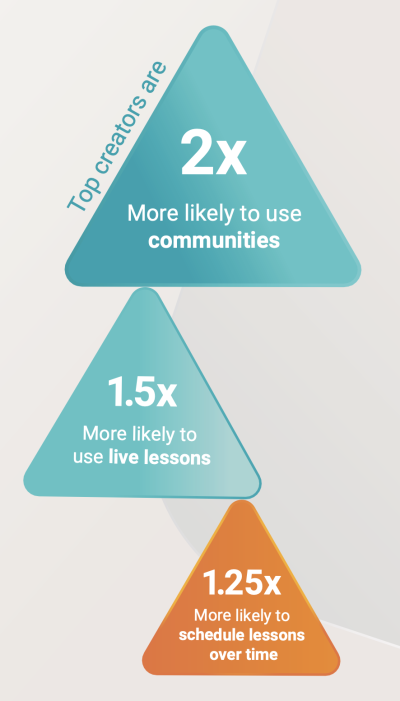
The first big trend is building a community into your courses.
Gone are the days when online learning was a solitary activity. Just the learner and the computer going through a linear learning process with little to no additional interaction apart from maybe an email question to the tutor.
Things have changed and students increasingly want to go beyond a series of video playlists consumed in a vacuum.
Students want to interact, exchange ideas, ask questions in real time and learn in groups.
Discussion groups aligned with a course are proving more engaging for the learner and the content they’re consuming is becoming more organic than just a static course.
What we’re talking about here is a shift towards building community around online learning.
Thinkific found that their top creators are twice as likely to use communities in their courses, one and a half times more likely to use live lessons in their courses, and one and a quarter times more likely to schedule lessons over time.
So what can you add to your courses to jump in on this trend?
Start building interactivity into your courses, enhance your video content with additional live sessions using things like Zoom – and perhaps use things like drip feed lessons to build cohorts of learners in semesters to create urgency and get more engagement.
The takeaways here are to get more personal with your course content. Your learners aren’t just anonymous individuals buying a course, they’re real people trying to solve real challenges and it’s in your interest to get to know them better as a customer so you can serve them better.
You need to keep working hard to get a community going and hopefully get it to a place where the community sustains itself.
Ultimately though maintaining a course community gives students a reason to return to your course beyond the content itself.
How Top Course Creators Are Selling More
The second big trend that Thinkfic discovered in the twenty twenty two Online Learning Trends report is the rise of multi product learning.
Whilst an online course might be the main event that brings in new customers to your knowledge business it doesn’t have to stop there.
If a learner is genuinely enjoying your course there will be many opportunities to offer upsells that provide even more value.
Thinkific found that their top course creators are expanding their business to offer memberships, ebooks, physical products, one to one coaching and more.
The data shows that eighty five percent of top creators sell more than one product or service, and shows a broader shift that course creators are making to diversify their revenue streams.

Giving students a few more options to buy into your learning universe means you could convert more customers and start getting them into a learning journey and sales funnel rather than losing them altogether if your single offering isn’t for them.
Offering multiple products or services also gives your audience multiple entry points into your business.
The main products top creators are focusing on expanding this year are memberships, coaching and digital downloads.
If you currently only have a single course for sale, how about selling a digital starter guide to give customers a low risk option to get started.
Or how about adding value to an existing course by creating a physical study guide that your students can purchase either separately or as a bundle with your course.
If you’re thinking of creating physical books, check out print on demand services from vendors like Lulu.com or Amazon’s KDP self publishing services which have no upfront costs and no risk of getting stuck with boxes of unsold physical stock.
Bundles are also a great way to increase order value for the customers that are all in on your courses.
Look to create complementary pieces of learning that students can purchase together, including things like personal coaching sessions, additional bonus courses, or even a membership package that includes multiple products.
Think about how you could expand your digital knowledge offerings and increase your average order value by using bundles
Build Your Online Course Business On Your Own Land
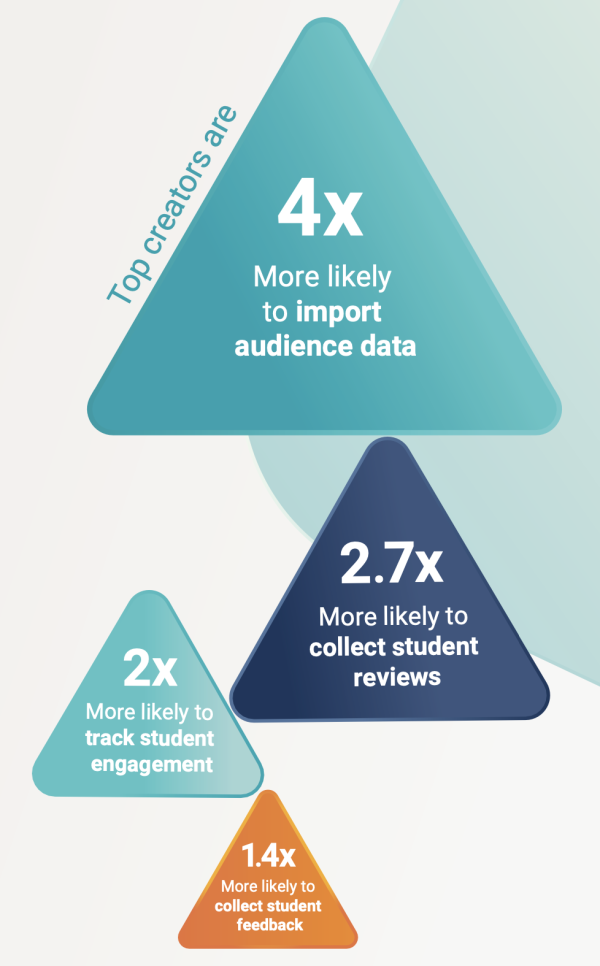
Here’s the third big trend Thinkific found in their report. Top creators take control of their data.
Rather than relying on third party platforms with followers or fans, creators are building a direct connection with each member of their community.
It’s prioritising that old adage of not building your business on other people’s land.
It’s becoming increasingly difficult to build an organic following on social media because to reach your audiences, most social platforms over the past decade are increasingly forcing creators to pay to reach even those people who are already interested in their content.
Even if you do manage to build any size of audience on social media, you have little or no control how the platform will serve up your content and you run the risk of any social platform changing it’s algorithm or guidelines and wiping out your channel and it’s followers you’ve painstakingly built up literally overnight.
The way to treat social media in 2022 is a stopping off point for your visitors.
You need to convert your social followers over to a platform you own, whether that is your own email list or a community that you own either on a tool like slack or perhaps you can move your social followers into a free mini course that has it’s own community attached.
When thinking about data, it’s not just about email lists either.
Top course creators are four times more likely to import audience data, just under three times more likely to collect reviews for their courses, twice as likely to track student engagement and nearly one and a half times more likely to collect student feedback.
You can use free tools like Google Sheets and Google Data Studio to analyse your student data and feedback and build dashboards that give you good information and insights for your course business.
The key takeaways here are that you need to make sure you’re always looking for ways to own your relationship with your audience.
If you’ve got any kind of following on social media, start moving them over to platforms that you own such as your email list or your website where you can have a connection with your customer directly, making sure of course to follow all of the relevant opt in and privacy rules.
Also make sure that you’re always asking your students how you can improve your knowledge business with surveys and reviews. Don’t be shy to ask people what they would like to see more of.
How To Sell More Online Courses – The End Of The Hard Sell
The final trend in the Thinkific twenty twenty two Online Learning Trends report is the end of the hard sell.
Some time ago in the early days of ecommerce, what we now know as landing pages or sales pages were called ‘squeeze pages’ which would literally squeeze the buyer’s journey into taking one option – the hard sell.
There’d be a huge long page with many paragraphs of text, eye catching images of happy people enjoying the results of what you’re teaching.
Scroll even further down the page and you’d see testimonials, time limited discounts and offers expiring at midnight.
and finally at the bottom of the page you’d get hit with the higher than you expected pricing hidden amongst the weeds.
This model of locking everything away behind a single paid checkout is changing though.
To get more leads in the door, creators are moving towards offering more free downloads, courses, and live events in 2022.

Customers now have much more choice when purchasing online, and they want to build a relationship and trust over a longer period of time before committing to a purchase.
It’s that classic “try before you buy” approach that gives students a chance to see the quality of your learning experience before they drop in their credit card details, and it gives you, the course creator, a chance to bring in more leads.
But that’s not the only way Thinkific are seeing the barriers break down between “free” and “paid” in their research.
The knowledge economy as a whole is shifting towards a future where pricing is integrated into the learning itself.
Rather than charge students once at the beginning of the relationship, top creators are shaking things up, and finding more success in the process.
Some of the latest tactics used by course creators include sixty seven percent offering free introductory courses, forty seven percent using live events, forty three percent offering free downloads and further down the list we see pre-order waitlists – effectively pre-selling your course – and targeted content still driving sales.
And if you’re curios about what other course creators are charging for their courses, Thinkific have pulled some average course prices per industry from their data.
Remember these are averages, and pricing your course is more of an art than a science.
Don’t fall into the trap of thinking charging less is always better though, because the more value you provide the higher price you can command, and remember, you can’t run or grow a business without adequate income to sustain it.

Check out our own blog post about course pricing called ‘what are you worth’ for the lowdown on all things course pricing.
Thinkific also reports seeing their top creators experimenting and becoming more flexible with their pricing.
The most successful course creators on the Thinkific platform appear to be twice as likely to offer subscription pricing and one and a half times more likely to upsell additional learning content.
Subscription content has been a growing trend for a few years.
people understand it now it’s part of their daily lives with things like Netflix, Spotify, even meal deliveries and other everyday services using subscription pricing models.
Monthly subscriptions lower the initial cost of access, and lower the risk for the buyer.
They also shift the focus away from the one time hard sell, and the ‘them and us’ conflict of a traditional sale, and moves the buyer into an ongoing relationship with the course creator.
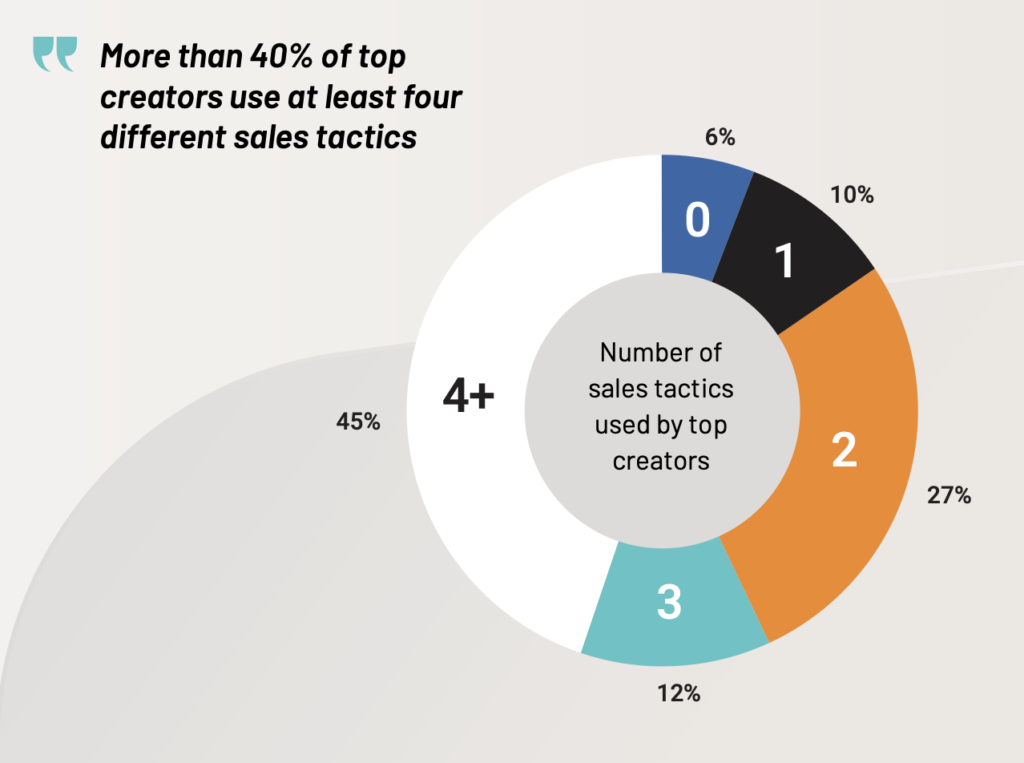
As a course creator, the name of the game in 2022 is to bring as many leads into your orbit as possible and to avoid the “hard sell”.
top creators are using more flexible pricing options and a greater number of tactics.
That’s why nearly 45% of top creators were using at least four different sales tactics – for example live events or free courses.
More than 40% of top creators use at least four different sales tactics
The takeaways for selling more courses in 2022 is to start building relationships as early as you can with your students.
Don’t just focus on selling your courses, give your community a journey into your courses.
Offer free introductory courses and downloads to prove your value and whet their appetite for what your full paid offering has in store for them.
Think about building value for your students over time with subscription revenues and offer upsells throughout the student’s learning journey.
Conclusions From The Thinkific 2022 Online Learning Trends Report
So here’s the key conclusions from Thinkific’s twenty twenty two Online Learning Trends Report.
The knowledge economy has changed a lot over the last few years. Everything from the type of content that students are demanding to the way creators are packaging the learning has shifted.
So if you’re still creating online courses the same way you were five years ago—you might be majorly missing the mark.
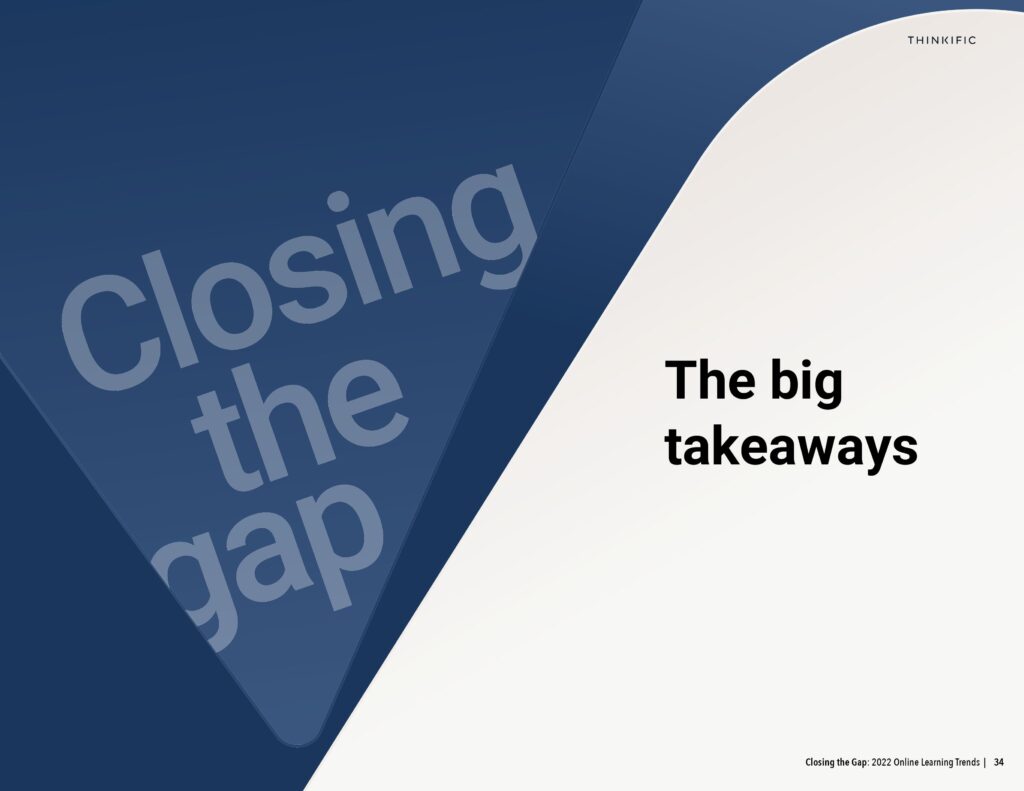
You don’t need to have a huge following on social media in order to be successful in the knowledge economy. There’s more opportunity today than ever before—and top creators are succeeding with smaller but more engaged audiences.
The key thing?
Make sure you’re delivering on the content your particular audience cares the most about.
Create a community around your course Don’t just build a course that students will want to consume once and then never come back to.
Instead, top creators are finding success by building communities around their courses with live lessons and weekly conversations that keep students engaged long after they complete the initial learning content.
Bundle multiple learning products together – give your audience a variety of different ways to engage with your brand, depending on how deep they want to go.
The goal is to build an onion of learning content—with more basic or accessible content (such as downloadable ebooks) serving as your outer layer, and more advanced or high-value content (such as one-on-one coaching) towards the core.
Take control of your audience relationships. Start looking for opportunities to transition your audience off “open” platforms like social media and onto platforms where you can “own” the relationship.
Top creators have a direct connection point to each member of their audience so they can easily promote new learning products and collect feedback.
Make the switch to value-based pricing Rather than asking students to pay steep upfront fees.
top creators are switching to subscription-based pricing where students pay lower monthly fees for as long as they’re seeing value in the content.
This can give you more predictable revenue and a reason to invest in the ongoing quality of your courses
Your Online Course Business Success & Report Download
After all is said and done though, while the data Thinkific have compiled in their twenty twenty two Online Learning Trends report shows that this advice works for most top creators – at the end of the day it’s the quality and effort that you put in that will determine your own success.
I want to thank all of the team at Thinkific that put so much hard work into researching and compiling this report, and if you’d like to grab your own copy of the report click the link below to download it now.
Got a question about any of the topics that are in the report, let us know in the comments or send us an email.

